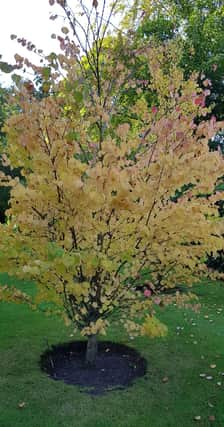GARDENING: ********* print headline in here ****************


That's one way of describing the autumn leaf colour change in deciduous trees and shrubs. It certainly lasts longer than the rockets, bangs, and cascades of bonfire night but there is one thing both these events have in common. They are based on chemical reactions.
The natural phenomenon now unfolding in our gardens, parks, and countryside, is based on plant survival. Tough leaves of evergreen trees and shrubs can take winter in their stride, likewise the conifers with their slim, wax-covered needles, but the Achilles heel of deciduous types is their thin, water-rich leaves. They would freeze and expand in the face of frost, destroying cellular tissue and putting the future of the parent plant at risk. So, it must
Advertisement
Hide AdAdvertisement
Hide Adshed them to protect itself but only after reabsorbing the valuable nutrients they have stored.
The catalysts in this scientific process are light and temperature, both of which decrease intensity as autumn progresses. Chlorophyll, the green colour pigment, is dominant, ever-present, and key to the food making process but it masks other leaf pigments. Only as it`s production diminishes, and photosynthesis slows down at this time of year, are they revealed. Carotenoids appear in yellow, orange, and brown, and they are followed by anthocyanin which is red.
Anthocyanin has the important task of keeping the nutrient-salvage operation from leaf to parent plant flowing before the transporting veins close. This is a race against time as cells at the base of each leaf stem, where it joins a branch, are in process of forming a separation layer. When this is completed the leaves fall.
Interestingly, look at the common beech hedge (Fagus sylvatica) in winter, note that the dead leaves are still clinging to branches and remain so until bud break in spring. This is because the separation layer has not completely formed.
Advertisement
Hide AdAdvertisement
Hide AdThe best weather conditions for prolonging our autumn leaf colour spectacle are warm, sunny days followed by cool evenings, with an absence of frost. Such daytime conditions encourage any remaining leaf chlorophyll to produce sugar, and the presence of anthocyanin ensures its passage into the parent plant.
Understanding the basic science behind this process can be as illuminating as the visual treats currently in our midst, not to mention increasing a sense of awe for the wonders of nature.
So, which trees and shrubs are the early stars of this big parade?
Cercidiphyllum japonicum is currently displaying smoky pink to yellow leaves but hurry, they fall very quickly. Pick up a handful to test for fragrance and discover why it's called the burnt sugar tree! Viburnum bodnantense leaves are blazing red, forsythia (yellow) and various maples are displaying an assortment of colours. You can see them all at The Alnwick Garden.
Advertisement
Hide AdAdvertisement
Hide AdLeaf fall is followed by the big sleep, a well-deserved rest for deciduous trees or shrubs intent on survival. Now we can safely move that fruit bush or tree that had outgrown its welcome or is struggling in the present position.
Perhaps dig out the shrub that is beginning to encroach on its perennial neighbours and move it to another part of the garden. Or, how about introducing something different whose recent leaf colour caught the eye and gave you that must-have feeling!
It is surprising what can be achieved when working by yourself on the relocation of a perennial, deciduous plant that at first glance looks too big to move. This need not involve lifting when a substantial root system with soil attached is the subject.
I start digging a reasonable distance from the main trunk or stem(s) and continue in a circle, with the spade upright. This severs radiating roots. Direct the spade deep underneath the tree or shrub, using the upper stems for leverage if necessary, until it loses anchorage. Use a stout post or similar, to lever the root ball out gradually onto a waiting sheet of material. Now it can be
dragged rather than lifted over soil or lawn, and will slide to its new destination, which of course has been well prepared in advance!